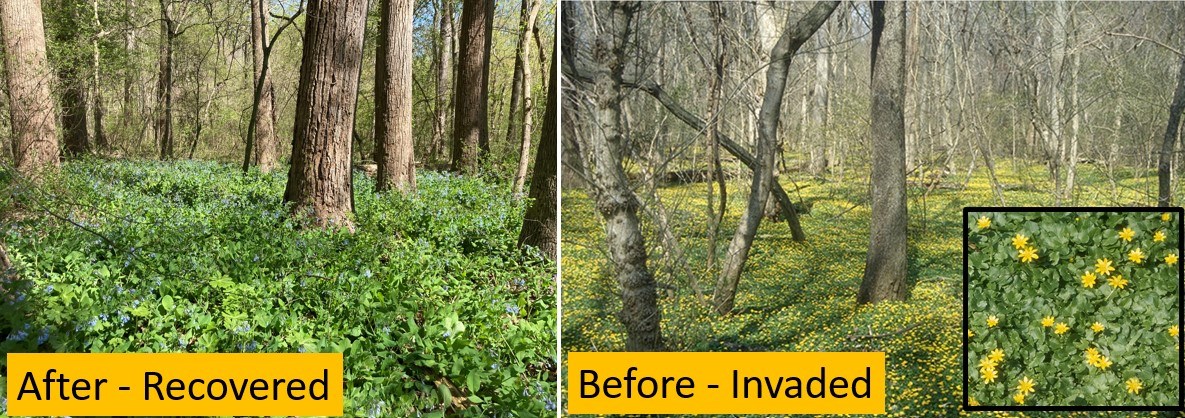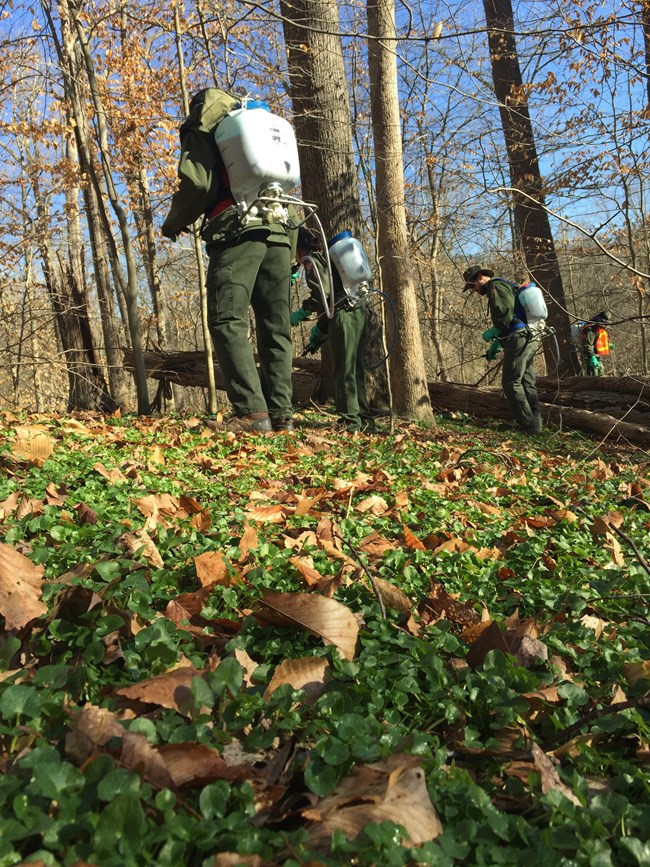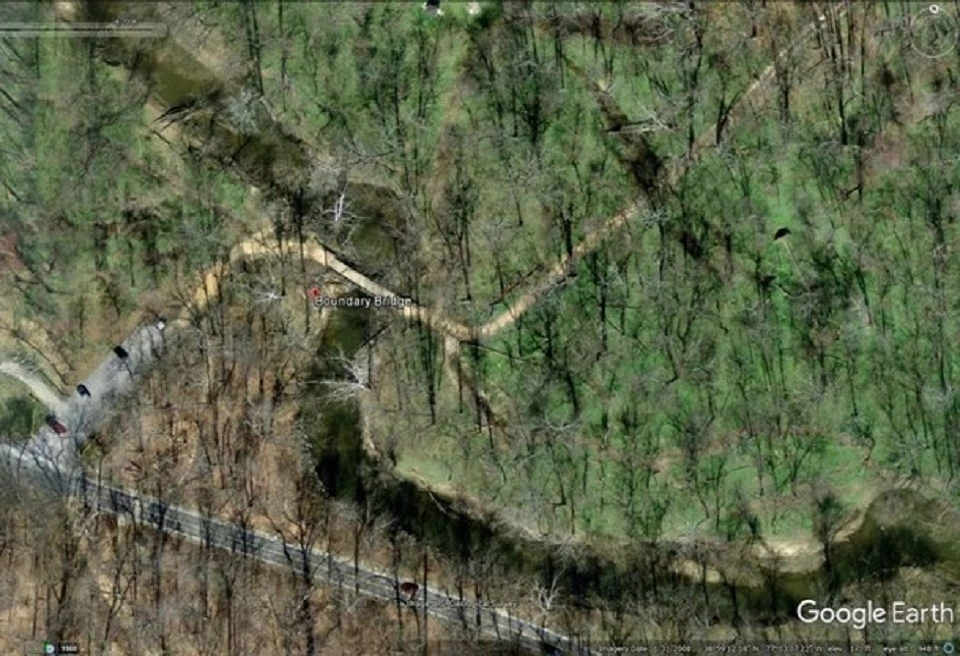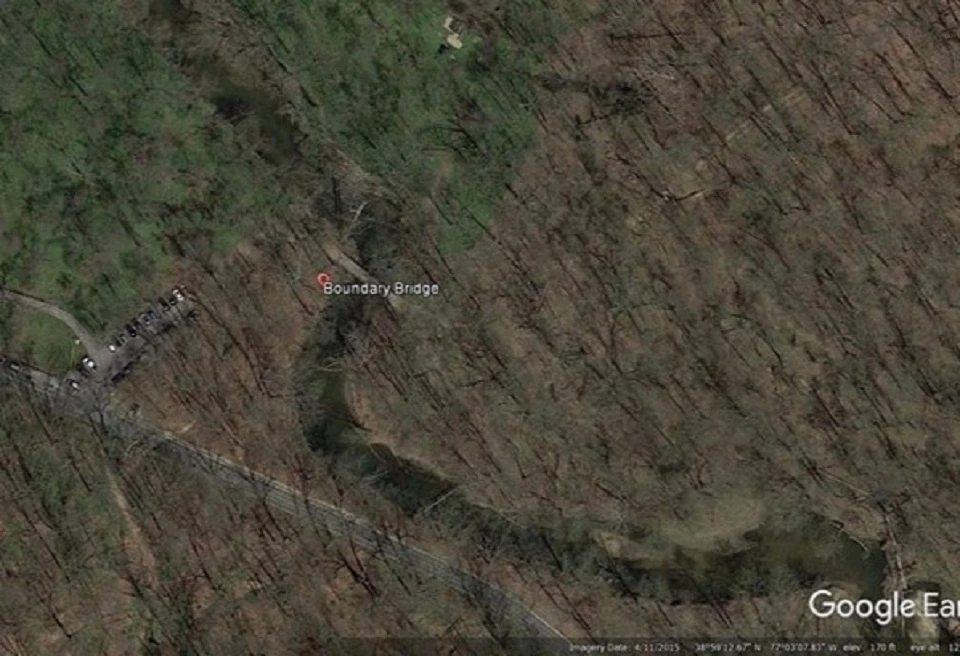Last updated: May 17, 2023
Article
Saving Floodplain Flowers in Rock Creek Park

All NPS/Tait except for bluebells, NPS/Chuquin
Less of Lesser Celandine
Like the European starlings first brought to North America by Shakespeare enthusiasts in the nineteenth century, the lesser celandine plant is an invasive species that has been here so long, you might mistake it for a native. But you couldn’t get further from the truth—the lesser celandine plant is an aggressive bully crowding out a host of native spring ephemeral flowers. Local naturalists such as Bob Ford and Bill Yeaman recall the northern floodplains in Rock Creek Park, between the northernmost boundary of the park and West Beach Drive bridge, prior to invasion by lesser celandine, as dominated by natives like spring beauties, dogtooth violet (a.k.a. trout lily), and Virginia bluebells. But by the year 2000 in many areas, instead of dots of pink, white, and blue amongst chalky green leaves, lesser celandine had painted waterways and floodplains with a solid blanket of dark green glossy leaves and buttercup yellow flowers.

Left Image: NPS/Chuquin
Right Image: NPS
However, cooperative and concerted action has returned the area’s springtime landscape once more to a diversified native plant pallette, allowing the recovery of one of the park’s most biodiverse areas. It’s an unrelenting challenge though as the small root bulbs of lesser celandine can persist even after the top of the plant is killed, and its bulbs and seeds can also hitchhike in from upstream areas with floodwaters.
In April 2023, park Botanist Ana Chuquin shared the success of the park’s efforts during a wildflower walk. Here’s the story.
Wait, That’s Not Native!?
According to Ohio State University Extension, lesser celandine (Ficaria verna – formerly Ranunculus ficaria) was first introduced to North America as an ornamental in the mid-1800s. Escapes were reported in Pennsylvania as early as 1867. (In some places, it’s still sold as a landscaping plant. Maryland outlawed its sale in 2017.)
Lesser celandine had become a problem invader in Rock Creek Park by 2000, as described in a 2002 report by Hammerschlag et.al. Researchers looking for the best treatment methods, concluded that chemical treatment rather than hand pulling was the most effective way to get rid of celandine without disturbing the bulbs and seeds of native plants preserved in the soil.
Because of its historically high number of spring ephemeral flowers, and its identification as one of the most highly biodiverse park areas, the park decided to treat lesser celandine on 35 acres of the northern floodplain. Limited funding for treatment was obtained in 2011 and the contractor ‘Invasive Plant Control’ handled most of management in the northern floodplains until the NPS regional Invasive Plant Management Team took over annual treatment in 2015.
As treatments have taken place, an immense variety of spring ephemeral flowers have returned and are successfully growing. These plants are not only beautiful to visitors, but they also provide food and habitat for native “mini-fauna”—the very small, native insects that are often specialists and rely on these flowers for food—and that get the larger food chain started.
The diverse species list below can now be seen in Rock Creek’s northern floodplain, thanks to much hard work and effort to fight back against lesser celandine. None were planted or re-introduced. They all have grown from the native seeds and bulbs already in the soil.

NPS/Voznitza
Native Spring Wildflowers in Rock Creek’s Northern Floodplain
-
Claytonia virginica (Spring beauty)
-
Sanguinaria canadensis (Bloodroot)
-
Podophyllum peltatum (Mayapple)
-
Dentaria laciniata (Cutleaf Toothwort)
-
Symplocarpus foetidus (Skunk Cabbage)
-
Mertensia virginica (Virginia Bluebells)
-
Stellaria pubera (Star Chickweed)
-
Thalictrum thalictroides (Rue Anemone)
-
Micranthes virginiensis (Early Saxifrage)
-
Asarum canadense (Wild Ginger)
-
Erythronium americanum (Yellow Trout Lily/Dogtooth Violet)
-
Viola pubescens eriocarpa (Common Yellow Violet)
-
Viola sororia (Common Blue Violet)
-
Viola canadensis (Canadian White Violet)
-
Dicentra cucullaria (Dutchman's Breeches)
- Caulophyllum thalictroides (Blue Cohosh)
- Enemion biternatum (False Rue Anemone)
Don’t Let Up
At present, funding provided for non-native, invasive plant management, does not allow the park to treat areas beyond the northern floodplain. Lesser celandine is so persistent that without follow-up treatment of already recovered areas, it re-occupies in a few years making it impossible to discontinue the treatment of one area to move to the next. Its bulbs and seeds also spread easily from park neighbors that do not manage infestations growing on their locations.
Lesser celandine continues to spread in other areas of the park, and throughout parks in the National Capital Region. But with concerted effort and action, recovery is possible.
References:
Hammerschlag et al. 2002. Ecology and Management of Ranunculus Ficaria in Rock Creek Park. DataStore - Ecology and Management of Ranunculus ficaria in Rock Creek Park (nps.gov)
Salmons. 2004. Rock Creek Park Invasive Exotic Plant Management Plan. DataStore - Invasive Exotic Plant Management Plan (nps.gov)
Plant Invaders of Mid-Atlantic Natural Areas (invasive.org)
Lesser Celandine | University of Maryland Extension (umd.edu)
Lesser Celandine: An Aggressive Non-Native Spring Ephemeral | BYGL (osu.edu)


Left image
Part of Rock Creek's northern floodplain blanketed with green lesser celandine in 2008.
Credit: Google Earth
Right image
Part of Rock Creek's recovered northern floodplain with lesser celandine removed in 2015.
Credit: Google Earth
